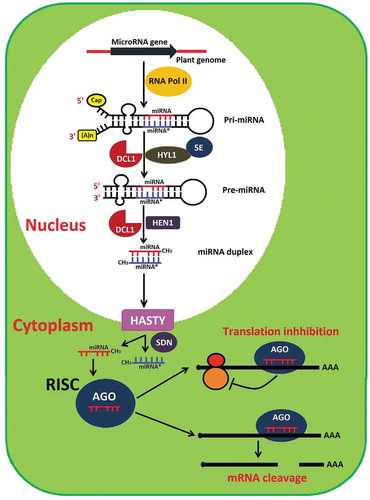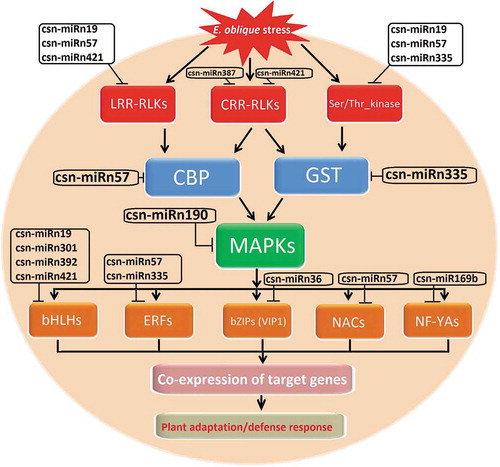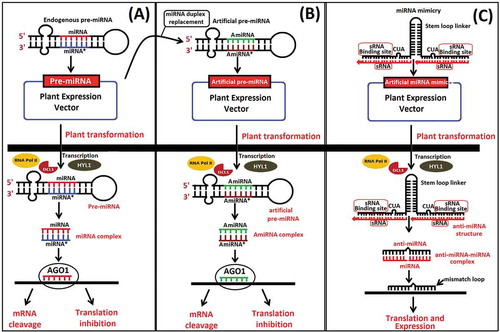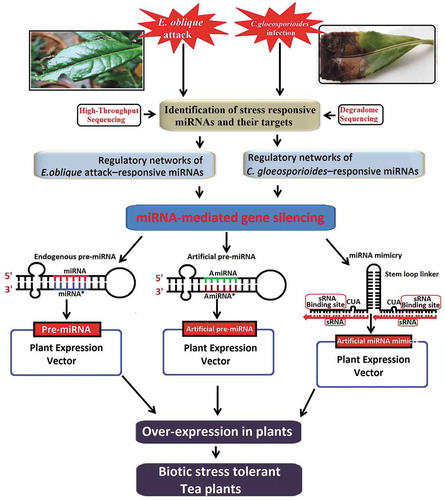Figures & data
Figure 1. The model of miRNA biogenesis and functions in plants. RNA polymerase II (RNA Pol II), primary transcripts (pri-miRNAs), stem-loop precursor miRNAs (Pre-miRNAs), DICER-LIKE-1 RNase III endonucleases (DCL1), double-stranded RNA (dsRNA) binding protein, HYPONASTIC LEAVES1 (HYL1), C2H2-zinc finger protein SERRATE (SE), s-adenosyl methionine-dependent methyltransferase HUA ENHANCER 1 (HEN1), exportin-5 homology protein (HASTY), small RNA degrading nuclease (SDN) class of exonucleases, RNA induced silencing complex (RISC), argonaute family protein (AGO1).

Table 1. Potential target transcripts of E. oblique-induced stress-responsive miRNAs in C. sinensis reported by Jeyaraj et al. (2017b).
Figure 2. The hypothetical model of regulatory networks of Ectropis oblique stress-responsive miRNA in tea plant. Leucine-rich repeat receptor-like protein kinase (LRR-RLKs), Cysteine-rich receptor-like protein kinase (CRR-RLKs), serine/threonine protein kinase (Ser/Thr kinase), glutathione S-transferase (GST), calcium-binding protein (CBP), mitogen-activated protein kinase (MAPKs), basic helix-loop-helix (bHLHs) transcription factor, ethylene-responsive transcription factor (ERFs), basic leucine zipper (bZIP) transcription factor (VIP1), NAC domain transcription factor (NACs) and Nuclear transcription factor Y subunit A (NF-YAs).

Table 2. Potential target transcripts of C. gloeosporioides-induced stress-responsive miRNAs in C. sinensis reported by Jeyaraj et al. (2019).
Figure 3. The hypothetical model of regulatory networks of Colletotrichum gloeosporioides–responsive miRNAs and their target genes in tea plant. Leucine-rich repeat protein kinase (LRR-PKs), serine/threonine protein kinase (Ser/Thr-PKs), LRR receptor-like Ser/Thr protein kinase (LRR-Ser/Thr-PKs), calcium-dependent protein kinase (CDPKs), mitogen-activated protein kinase (MAPKs), WRKY family transcription factor (WRKYs), NAC domain transcription factors (NACs), nuclear transcription factor Y (NF-YAs), auxin response factor (ARFs), Myb domain proteins (MYBs), nucleotide-binding site leucine-rich repeat (NBS-LRRs), catalases isozyme1 (CAT), L-ascorbate peroxidase (L-APX), glutathione reductase (GR), glutathione S-transferase (GST), cytochrome c oxidase (COX), peroxidase (POX), phenylalanine ammonia-lyase (PAL).

Figure 4. The general mechanism of miRNAs (A), amiRNAs (B) and target mimicry (C) in plants. RNA polymerase II (RNA Pol II), stem-loop precursor miRNAs (Pre-miRNAs), DICER-LIKE-1 RNase III endonucleases (DCL1), double-stranded RNA (dsRNA) binding protein, HYPONASTIC LEAVES1 (HYL1), s-adenosyl methionine-dependent methyltransferase HUA ENHANCER 1 (HEN1), argonaute family protein (AGO1).

Figure 5. Hypothetical model of miRNA identification and its strategies that target mRNA for the improvement of tea plant against biotic stress factors. Invading Ectropis oblique elicitor or Colletotrichum gloeosporioides pathogen can trigger the production of tea plant endogenous miRNAs that can target their respective mRNA for degradation were determined by HTS and degradome sequencing. Although tea plant-Ectropis oblique or Colletotrichum gloeosporioides derived miRNA-mediated gene silencing have not yet been discovered, we illustrate hypothetical model that identified miRNAs and target will be used to generate transgenic plants with miRNA-mediated gene silencing approaches, namely, over-expression of endogenous miRNA, artificial miRNA, miRNA mimic which will induce or suppress of the host and pathogen transcripts to generate biotic stress tolerance in tea plant.

